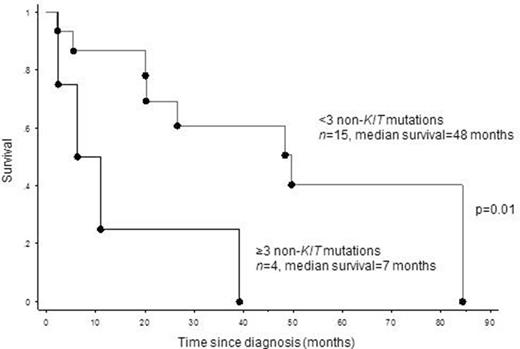Abstract
Background: KIT D816V is considered the driver mutation in systemic mastocytosis (SM) however this mutation alone does not explain the diverse clinical manifestations of SM. While mutations in other myeloid-relevant genes have been reported in SM, their pattern(s) of co-segregation and prognostic value, independent of age and SM subtype, have not been fully defined in a mature dataset.
Objectives: In this pilot study of advanced SM patients, we sequenced a panel of myeloid-relevant genes for known pathogenic mutations, to ascertain: (i) the frequency of individual mutations; (ii) the pattern(s) of mutation co-segregation; and (iii) the prognostic value of mutations, both individually and in combination, on overall- (OS) and leukemia-free survival (LFS).
Methods: The current study was approved by the Mayo Clinic institutional review board. SM was classified as per World Health Organization criteria. DNA was isolated from archived bone marrow (BM) cell pellets. Next-generation deep sequencing by HiSeq SBS chemistry (Illumina) was performed to investigate the coding regions of 22 genes: KIT, JAK2, CALR, SRSF2, U2AF1, SF3B1, ASXL1, TET2, EZH2, SETBP1, DNMT3A, IDH-1/2, SUZ12, CBL, NRAS, FLT3, PTPN11, RUNX1, CEBPA, TP53 and NPM1.
Results: We studied 19 patients with advanced SM; 6 had aggressive SM (ASM) and 13 had SM with an associated hematological disease (SM-AHD). Of the latter, 5 patients (38%) had myeloproliferative neoplasm-unclassified (MPN-u), 3 (23%) chronic myelomonocytic leukemia (CMML), 2 (15%) acute myeloid leukemia (AML), and 1 (8%) each polycythemia vera, myelodysplastic syndrome, and multiple myeloma. The median follow up from diagnosis was 20 months (range 2 to 84). Over this period, 5 patients (26%) developed leukemic transformation and 12 patients (63%) have died.
KIT D816V was identified in 9 (47%) patients; 9 of 10 patients who tested negative by deep sequencing were screened by allele-specific PCR (sensitivity ~0.01%), with 8 additional patients testing positive. Thus, overall KIT D816V frequency was 89%. Fourteen (74%) patients harbored at least one additional non-KIT mutation; of these 7 patients had one additional mutation (ASXL1/TET2/SF3B1 = 2 each and JAK2 =1), 3 patients each had two and three additional mutations, and 1 patient had 4 additional mutations. The most frequently mutated genes (other than KIT) were ASXL1/TET2 (5 patients each, 26%), CBL (4 patients, 21%), SETBP1/SF3B1/DNMT3A (2 patients each, 11%) and JAK2/CALR/FLT3/IDH-1/RUNX1/TP53 (1 patient each, 5%). There was no overlap between patients harboring TET2 and ASXL1 mutations however 2 and 1 CBL-mutated patients concurrently harbored TET2 and ASXL1 mutations, respectively. SETBP1 and SF3B1 but not DNMT3A mutations occurred independently of TET2 and ASXL1 mutations. The distribution of mutations was similar between ASM and SM-AHD subgroups.
When considered individually, the following non-KIT mutated genes (present in at least 2 patients) were associated with significantly inferior OS: ASXL1, CBL and SETBP1 (p<0.05). When the 3 mutated genes were considered together, only ASXL1 and CBL maintained their significance, independent of age and SM subtype, for inferior OS (Hazard ratio (95% confidence interval)=34.8 (3.1-393.9) and 59.7 (4.1-861.5), respectively). Patients harboring ASXL1 and/or CBL mutations (n=8, 8 deaths, median OS=11 months) had a significantly worse OS as compared to those without either mutation (n=11, 4 deaths, median OS=84 months) (p=0.0002) (Fig 1). When considering the number of non-KIT mutations (zero, one, two, three and four mutations in 5, 7, 3, 3 and 1 patients, respectively), the group with ≥3 mutations (n=4, 4 deaths, median OS=7 months) had a significantly inferior OS as compared to those with <3 mutations (n=15, 8 deaths, median OS=48 months) (p=0.01) (Fig 2). Presence of mutations was not correlated with LFS in this analysis.
Conclusions: In this cohort of advanced SM patients, non-KIT mutations were frequent (prevalence 74%). TET2, ASXL1, SETBP1 and SF3B1, but not CBL or DNMT3A, mutations were mutually exclusive. Presence of ASXL1 and CBL mutations was associated with significantly inferior OS (HR=35 and 60, respectively), independent of known prognostic factors. An increasing number of non-KIT mutations (≥3, HR=5.9) was also associated with a significantly worse survival outcome. Sequencing results from a larger cohort will be presented at the meeting.
Pardanani:Stemline: Research Funding.
Author notes
Asterisk with author names denotes non-ASH members.



This feature is available to Subscribers Only
Sign In or Create an Account Close Modal